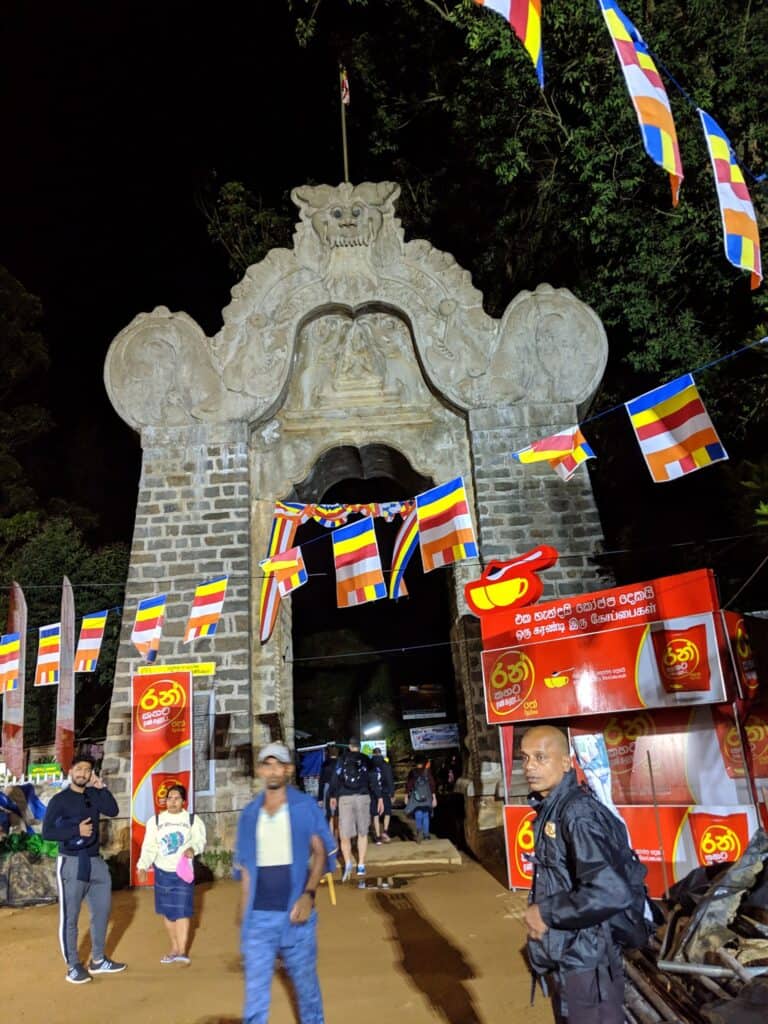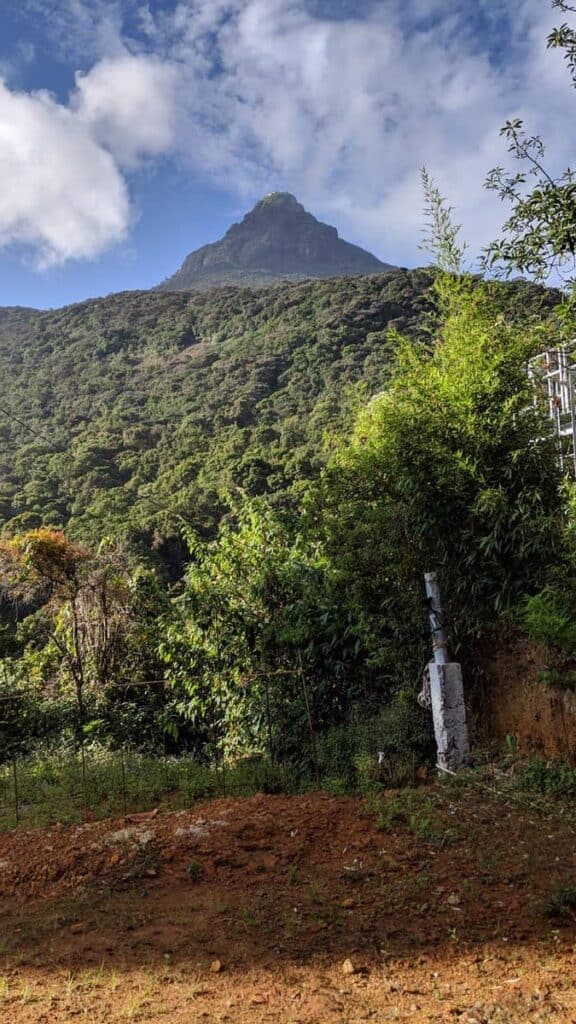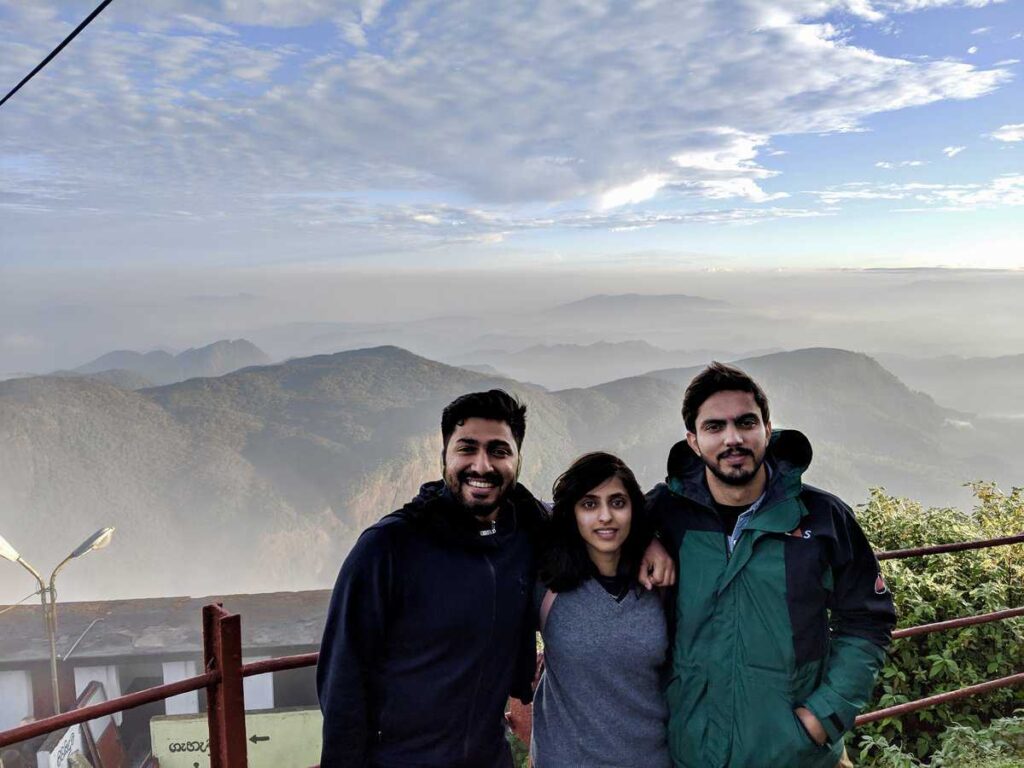Some hikes are about getting away from people, reconnecting with nature, and finding quiet. This is not one of those hikes.
I climbed Adam’s Peak on a whim — no real spiritual motivation, just a stubborn desire to say I’d climbed Sri Lanka’s most famous mountain. My friend and I wanted to do a hike together, and this one kept showing up in blogs and guidebooks. It looked epic. Cultural. Iconic. Hard to ignore.
What no one really tells you is how absolutely unserene the experience is. Thousands of pilgrims. A 2:30 a.m. start. An endless vertical staircase. Noisy, crowded, and weirdly moving — all at once.
If you’re thinking of climbing Adam’s Peak in Sri Lanka (also known as Sri Pada), whether for the views, the challenge, or the spiritual curiosity, here’s my advice. The good, the bad, the knee pain. Let’s go.
What Is Adam’s Peak (and Why Do People Climb It?)
Adam’s Peak, also known as Sri Pada, is one of Sri Lanka’s most sacred mountains — and also one of its most climbed. At 2,243 meters (7,359 feet), it’s not the tallest in the country, but it carries enormous weight in spiritual clout.
This single mountain is believed by different faiths to mark wildly different things: for Buddhists, it’s the place where Buddha left a footprint; for Hindus, it’s where Shiva descended; Muslims and Christians believe it’s where Adam first set foot on Earth after being cast out of paradise.
It’s a mountain layered with meaning. Every step is a ritual, and every climber is there for a reason — whether it’s religious, personal, or just a once-in-a-lifetime challenge.
Who Should (and Shouldn’t) Climb Adam’s Peak
Adam’s Peak isn’t a nature escape or a quiet mountaintop meditation. It’s a steep, crowded, 5,500-step pilgrimage — done in the dark, often with zero sleep. But it’s also one of the most unique cultural experiences in Sri Lanka.
Here’s who it’s right for, and what to expect.
It’s Worth It If:
Maybe Skip It If:
On the difficulty scale, it’s moderate-to-hard: no technical sections, but a relentless stair climb that takes most people 3–4 hours to summit. Descending takes another 2–3 hours — and hurts more than you think.


Best Time to Climb Adam’s Peak
The official season runs from December to May, with January to April offering the best odds for clear skies and a proper sunrise. Outside of those months, the weather turns unpredictable and the trail goes unlit — which makes for a much sketchier climb.
When to Avoid (Seriously)
- Poya days (full moons) – These are sacred in Sri Lanka. You’ll be hiking in a moving wall of people, shoulder to shoulder, for hours.
- Weekends and holidays – Unless you love a stairway traffic jam at 3 a.m., avoid peak days.
- Off-season (May to October) – It’s quieter, yes, but also rainy, slippery, and dark. The path won’t be lit, and many guesthouses shut down. Bring a headlamp and low expectations.
What Time Should You Start?
To catch the sunrise from the summit, plan to arrive 30 minutes before dawn. That means starting your hike between 2:00–2:30 a.m., depending on your pace.
- Average hikers: 3–4 hours to the top
- Slower pace / frequent breaks: Start closer to 1:30–2:00 a.m.
- Fast and fit: You can push it later, but risk missing the sunrise
There’s nothing more tragic than climbing 5,000 stairs in the dark only to miss the whole reason you came. Don’t gamble.
How to Get to Adam’s Peak (Trailhead: Dalhousie)
Adam’s Peak is in central Sri Lanka. The main trail starts from Nallathanniya, also known as Dalhousie, with Hatton as the main transport hub nearby.
Option 1: Train + Bus (or Tuk-Tuk)
Ideal for: Budget travelers or anyone who enjoys staring out train windows
- Take the scenic train to Hatton from Colombo, Kandy, or Ella (Kandy–Hatton stretch is especially good) – particularly beautiful if you’re traveling from Ella, where we’d spent a few lazy days exploring and waterfall chasing.
- From Hatton:
- Bus to Dalhousie (1.5–2 hours, daytime only, Rs. 100)
- Tuk-tuk if you arrive late or want flexibility (Rs. 2,500–4,000)
Option 2: Private Taxi or Ride-Share
Ideal for: Groups, tight timelines, or people who hate logistics
- Colombo → Dalhousie: 4–5 hours, Rs. 15,000–20,000 ($45–60)
- Kandy → Dalhousie: ~3 hours
Not cheap, but split between a few people, it’s manageable — and far less headache.
Important: Get to Dalhousie the Night Before
This isn’t the kind of hike you roll into last minute. Plan to arrive in Dalhousie by evening, grab dinner, and crash early. Sorting out transport at midnight on zero sleep before a 2:30 a.m. climb is a rookie move. Don’t do it.We slotted Adam’s Peak about midway through our route, which worked out well energy-wise — you can read more about how we structured our full Sri Lanka itinerary here.


WWhere to Stay Before the Climb
At 2 a.m., distance matters. The closer you sleep to the trailhead, the less you’ll hate your life in the middle of the night.
There are two main places to base yourself: Dalhousie (Nallathanniya) and Maskeliya. Dalhousie is right at the start of the trail — loud and busy, but logistically unbeatable. Maskeliya is quieter and prettier, but you’ll need to tuk-tuk in the dark.
TL;DR:
| Location | Vibe | Distance to Trail | Pros | Cons |
| Dalhousie | Busy, practical | 5–10 min walk | Roll out of bed and start hiking | Noisy, overbooked in season |
| Maskeliya | Scenic, peaceful | 30–40 min drive | Quieter, lake views | Requires late-night transport |
📍 Dalhousie: Best for Ease + Early Starts
If your main goal is to make it to the summit before sunrise with minimal drama, stay in Dalhousie. You’ll be out the door and on the steps in under 10 minutes — no need to negotiate a 3 a.m. tuk-tuk ride.
Most accommodations here are simple: expect thin walls, firm mattresses, and sometimes cold water. But they’re functional — and many cater specifically to Adam’s Peak hikers.
Recommended stays:
- Slightly Chilled Guest House – One of the most popular choices. Private rooms with balconies, solid food, warm showers, and great views of the peak. It’s close enough to the trailhead but tucked a little off the main road, which helps with noise.
- Wathsala Inn – Family-run, very welcoming, decent meals, and one of the oldest setups in town. A bit rustic, but gets the job done if you’re just crashing before the climb.
- Queensark – Where I stayed. Clean-ish, very no-frills, but unbeatable location — about five minutes from the trail. Don’t expect anything fancy, but if all you need is a bed and a backup generator, it’ll do.
⚠️ In season (especially around Poya days), book ahead — guesthouses fill quickly and walk-ins might leave you with nothing but the floor.
📍 Maskeliya: Best for Quiet + Views
If you’re arriving early and want a more relaxed evening before the chaos, Maskeliya can be a great alternative. It’s a scenic little lakeside town with fewer crowds and prettier surroundings — perfect if you’re the type who wants to unwind with a view and get some sleep.
Just keep in mind: you’ll need to arrange a tuk-tuk for the morning climb (30–40 minutes). And make sure your driver actually knows the trailhead entrance — not all do.
Recommended stays:
- Mandira Craig Appin Bungalow – A charming colonial-era bungalow with lake views and lush gardens. Definitely more comfort-focused — ideal if you’re not on a tight budget.
River Side Inn Maskeliya – A more affordable option that still feels peaceful and homey. Family-run, good food, and clean rooms with mountain views.

What the Climb Is Actually Like
The Ascent
The first 20–30 minutes lull you into a false sense of confidence. It’s a gentle walk through small shops and tea stalls, lit with string lights and lined with sleepy vendors selling socks, water, and warm layers.
Then the stairs begin. And they don’t stop.
The trail turns into a steep, uneven staircase carved straight into the mountain. No switchbacks, no flat bits to catch your breath — just step after step after step. Most people take 3–4 hours to reach the top, depending on fitness, crowds, and how often you stop to rest or question your life choices.
We started around 2:30 a.m. and quickly fell into a slow, steady rhythm. Despite the dark and the incline, there’s something moving about climbing alongside grandparents with walking sticks, parents carrying toddlers, and teenagers blasting devotional music on their phones. Everyone’s in it together, and weirdly, that helps.
Bring a headlamp, even during peak season. The trail is lit in parts, but not consistently — and shadows on stone stairs are not your friend.
Reaching the Summit
The top gets crowded fast — and narrow. The final stretch can bottleneck near the temple entrance, especially on weekends or Poya nights, so if you want a good sunrise spot, don’t dawdle.
At the summit is a small temple said to house the sacred footprint — believed by some to be Buddha’s, others Shiva’s, Adam’s, or St. Thomas’s. It’s just an indentation in the rock, but watching the way people react — bowing, weeping, lighting incense — is a quiet reminder that this mountain means a lot more than just a good view.
Tradition says you can ring the bell once for every successful summit. I rang it once. Once was enough.
Sunrise
Right before dawn, the temperature drops sharply. Expect 5–10°C (41–50°F) at the summit, with wind. Layers, gloves, and a scarf or buff will save you from shivering through the main event.
Then the sky begins to shift — deep blue to pink to orange — and just as the sun crests the horizon, you’ll see the perfect pyramid-shaped shadow of Adam’s Peak stretch across the clouds below. It’s surreal. Cameras don’t really do it justice. For a few minutes, everyone just… stops.
If you’re lucky with the weather, this is the moment that makes the whole climb worth it.
The Descent
Coming down is faster but rougher. Your legs are tired, the sun is up, and gravity turns against you. It took us around 2.5 hours to descend, and by the bottom, my knees felt like jelly.
There are no railings for much of the trail, so if you’re prone to joint pain or instability, bring a walking stick or knee brace. Also: take breaks. You’re not impressing anyone by sprinting down.
Plan a beach day after — seriously. You’ll want to recover somewhere with cold drinks, no stairs, and ocean views. If you’re looking for ideas, check out some of our favorite coastal spots around the island.

Essential Tips for Climbing Adam’s Peak
Toilets
- Squat toilets available along the trail
- Often dirty, rarely stocked — bring toilet paper or wet wipes
Crowds
- Peak crowds = full moons, weekends, and holidays
- Expect human traffic jams near the summit
After the Climb
- The descent is brutal. Bring a walking stick, knee brace, or painkillers
- Don’t plan big travel moves after. Schedule time to eat, shower, and not move for a while
What to Pack
Essentials:
- Headlamp or torch (with extra batteries)
- Layers for the summit: fleece, windbreaker, gloves
- 1–2 liters of water
- Snacks: bananas, nuts, chocolate, trail mix
- Cash (Rs. 1,000–2,000 in small notes)
- Wet wipes or toilet paper
- Hat or scarf for wind
- Walking stick or knee support (if needed)
- Rain gear (Dec–Jan and off-season climbs especially)
Optional but useful:
- Extra socks
- Lightweight blanket or scarf to sit on
- Painkillers or muscle spray
Total Cost Breakdown
| Item | Cost (LKR) | USD Approx. | Notes |
| Guesthouse in Dalhousie (1 night) | 3,000 | $9 | Basic double room |
| Train: Kandy → Hatton | 500 | $1.50 | Book ahead if possible |
| Tuk-tuk: Hatton → Dalhousie | 3,000 | $9 | Can split with others |
| Snacks + water on trail | 1,000 | $3 | Bring some, buy some |
| Meals (dinner + post-hike breakfast) | 1,500 | $4.50 | Guesthouse/street food |
| Warm gear (gloves, hat – if needed) | 1,000 | $3 | Sold along trail |
| Donations (optional) | 500 | $1.50 | To support temple upkeep |
Estimated Total (solo traveler): ~10,500 LKR / ~$32.
Traveling with others? Costs drop. Going off-season or private taxi from Colombo? Expect to spend more.
Final Reflection: Is Adam’s Peak Worth It?
It’s not the kind of hike I’d do twice.
There’s no quiet trail moment, no forest breeze, no chance to zone out with birdsong. It’s crowded. It’s vertical. It’s exhausting. And yet… I’m still glad we did it.
Climbing Adam’s Peak isn’t about solitude or scenery — it’s about being part of something bigger. A barefoot auntie overtaking you while chanting. A stranger handing you ginger tea on the way up. That hush before the sunrise, when thousands of people stop and stare in the same direction.
You don’t have to believe in the footprint to feel the weight of it.
We did it as part of a very non-traditional bachelorette trip, which made the whole thing feel even more surreal — sore legs, spiritual chaos, and all. For me, it was a one-time thing — and that was enough. But if you’re in Sri Lanka and curious to see faith, fatigue, and human willpower all climbing the same mountain? It’s absolutely worth the stairs.
Just don’t forget the socks.
Related Posts
- Girls Trip to Sri Lanka
- Sri Lanka Itinerary: What to See in 10 Days of Adventure
- Climbing Adam’s Peak in Sri Lanka: A Comprehensive Guide
- The 9 Best Beaches in Sri Lanka: From Hidden Gems to Surfing Spots
- How to Visit Train Street Hanoi (Without Being That Tourist)
- 13 Unmissable Things to Do in Ninh Binh
